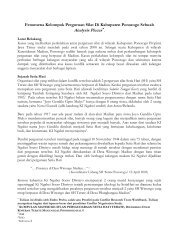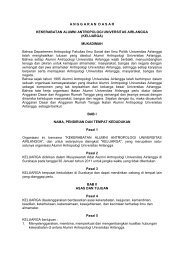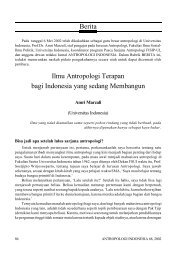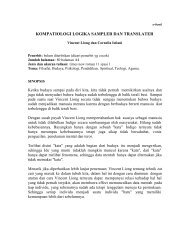The Future of Visual Anthropology: Engaging the Senses
The Future of Visual Anthropology: Engaging the Senses
The Future of Visual Anthropology: Engaging the Senses
Create successful ePaper yourself
Turn your PDF publications into a flip-book with our unique Google optimized e-Paper software.
widijanto judono e-Library collection - widijanto.wordpress.com<br />
indeed all first-hand social research <strong>of</strong> any kind, must be collaborative to some<br />
extent’ because ‘<strong>the</strong> researcher’s very presence amongst a group <strong>of</strong> people is <strong>the</strong><br />
result <strong>of</strong> a series <strong>of</strong> social negotiations’ (2001: 119). Even Mead’s observational<br />
photographic study in Bali involved her collaboration with informants as critics.<br />
Indeed, seeing research as a collaborative process goes hand in hand with a critique<br />
<strong>of</strong> a purely observational approach. This is, first, because <strong>the</strong> latter implies doing<br />
research about or on people, treating <strong>the</strong>m as objects, whilst <strong>the</strong> former implies<br />
working with informants, attempting to understand and represent <strong>the</strong>ir points <strong>of</strong><br />
view and experiences. Second, whereas an observational approach depends on<br />
assumptions about <strong>the</strong> accessibility <strong>of</strong> information about ‘reality’ through what is<br />
visible, a collaborative approach demonstrates how many aspects <strong>of</strong> experience and<br />
knowledge are not visible, and even those that are visible will have different meanings<br />
to different people (see Pink 2001a: 23–4). Finally, visual anthropologists view<br />
image production and <strong>the</strong> negotiations and collaborations that this involves as part<br />
<strong>of</strong> a process by which knowledge is produced, ra<strong>the</strong>r than as mere visual notetaking.<br />
Collaboration is important in any project that involves people and images;<br />
both on ethical grounds and as a way <strong>of</strong> recognising <strong>the</strong> intersubjectivity that<br />
underlies any social encounter. As Banks sums up ‘Swooping god-like into o<strong>the</strong>r<br />
people’s lives and ga<strong>the</strong>ring “data” (including “visual data”) according to a predetermined<br />
<strong>the</strong>oretical agenda strikes me as not simply morally dubious but intellectually<br />
flawed’ (2001: 179; see also Pink 2001a: 36–46). Collaboration might not go<br />
beyond <strong>the</strong> idea <strong>of</strong> <strong>the</strong> researcher asking informants to collaborate with her or him<br />
in order to achieve <strong>the</strong> ends <strong>of</strong> a social research project, but it also may involve<br />
projects in which informants are empowered through <strong>the</strong> production <strong>of</strong> images that<br />
will serve to represent <strong>the</strong>m and fur<strong>the</strong>r <strong>the</strong>ir own causes.<br />
Conclusion<br />
Interdisciplinary agendas 37<br />
In <strong>the</strong> introduction to this chapter I proposed that <strong>the</strong> ‘new’ visual methods, as<br />
represented from different disciplinary perspectives, have common interests in<br />
reflexivity, collaboration, ethics and <strong>the</strong> relationship between content, context and<br />
<strong>the</strong> materiality for images. Never<strong>the</strong>less, <strong>the</strong>y diverge in <strong>the</strong>ir definitions and uses<br />
<strong>of</strong> <strong>the</strong>se to achieve particular disciplinary aims. Here lies one <strong>of</strong> <strong>the</strong> difficulties <strong>of</strong><br />
interdisciplinary critique. Although I feel that Emmison and Smith’s critique <strong>of</strong><br />
visual anthropology is misinformed and inappropriate, I would also recognise that it<br />
has been made by researchers who have a very different agenda to that <strong>of</strong> contemporary<br />
visual anthropologists. I have suggested that a visual anthropological<br />
approach to <strong>the</strong> intersubjectivity through which ethnographic knowledge is<br />
produced would enhance Rose’s perspective on how one might research how<br />
meanings are created through <strong>the</strong> negotiations between human and image agencies<br />
and ‘audiencing’. My critique is made as an anthropologist with a particular<br />
approach to ethnography and reflexivity, which has quite different concerns from<br />
those who study audiencing. Interdisciplinary critique and collaboration are<br />
complicated and provoke all kinds <strong>of</strong> sensitivities. Our shared concerns could










